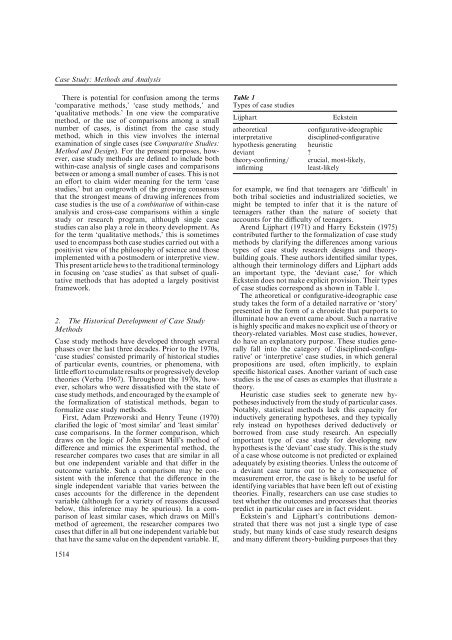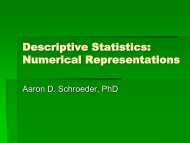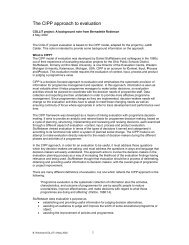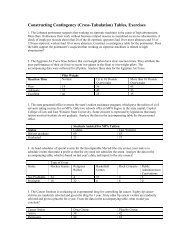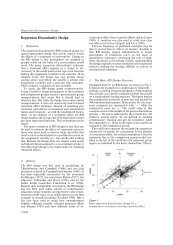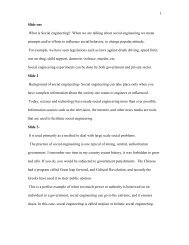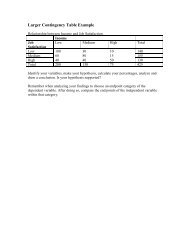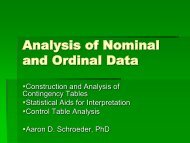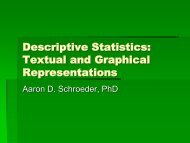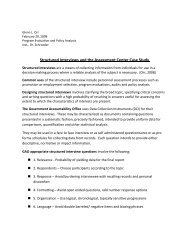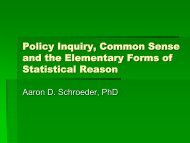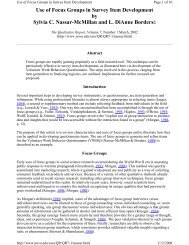Case Study: Logic
Case Study: Logic
Case Study: Logic
Create successful ePaper yourself
Turn your PDF publications into a flip-book with our unique Google optimized e-Paper software.
<strong>Case</strong> <strong>Study</strong>: Methods and Analysis<br />
There is potential for confusion among the terms<br />
‘comparative methods,’ ‘case study methods,’ and<br />
‘qualitative methods.’ In one view the comparative<br />
method, or the use of comparisons among a small<br />
number of cases, is distinct from the case study<br />
method, which in this view involves the internal<br />
examination of single cases (see Comparatie Studies:<br />
Method and Design). For the present purposes, however,<br />
case study methods are defined to include both<br />
within-case analysis of single cases and comparisons<br />
between or among a small number of cases. This is not<br />
an effort to claim wider meaning for the term ‘case<br />
studies,’ but an outgrowth of the growing consensus<br />
that the strongest means of drawing inferences from<br />
case studies is the use of a combination of within-case<br />
analysis and cross-case comparisons within a single<br />
study or research program, although single case<br />
studies can also play a role in theory development. As<br />
for the term ‘qualitative methods,’ this is sometimes<br />
used to encompass both case studies carried out with a<br />
positivist view of the philosophy of science and those<br />
implemented with a postmodern or interpretive view.<br />
Thispresentarticlehewstothetraditionalterminology<br />
in focusing on ‘case studies’ as that subset of qualitative<br />
methods that has adopted a largely positivist<br />
framework.<br />
2. The Historical Deelopment of <strong>Case</strong> <strong>Study</strong><br />
Methods<br />
<strong>Case</strong> study methods have developed through several<br />
phases over the last three decades. Prior to the 1970s,<br />
‘case studies’ consisted primarily of historical studies<br />
of particular events, countries, or phenomena, with<br />
littleeffort to cumulateresults or progressively develop<br />
theories (Verba 1967). Throughout the 1970s, however,<br />
scholars who were dissatisfied with the state of<br />
case study methods, and encouraged by the example of<br />
the formalization of statistical methods, began to<br />
formalize case study methods.<br />
First, Adam Przeworski and Henry Teune (1970)<br />
clarified the logic of ‘most similar’ and ‘least similar’<br />
case comparisons. In the former comparison, which<br />
draws on the logic of John Stuart Mill’s method of<br />
difference and mimics the experimental method, the<br />
researcher compares two cases that are similar in all<br />
but one independent variable and that differ in the<br />
outcome variable. Such a comparison may be consistent<br />
with the inference that the difference in the<br />
single independent variable that varies between the<br />
cases accounts for the difference in the dependent<br />
variable (although for a variety of reasons discussed<br />
below, this inference may be spurious). In a comparison<br />
of least similar cases, which draws on Mill’s<br />
method of agreement, the researcher compares two<br />
cases that differ in all but one independent variable but<br />
that have the same value on the dependent variable. If,<br />
Table 1<br />
Types of case studies<br />
Lijphart<br />
Eckstein<br />
atheoretical configurative-ideographic<br />
interpretative disciplined-configurative<br />
hypothesis generating heuristic<br />
deviant ?<br />
theory-confirming<br />
infirming<br />
crucial, most-likely,<br />
least-likely<br />
for example, we find that teenagers are ‘difficult’ in<br />
both tribal societies and industrialized societies, we<br />
might be tempted to infer that it is the nature of<br />
teenagers rather than the nature of society that<br />
accounts for the difficulty of teenagers.<br />
Arend Lijphart (1971) and Harry Eckstein (1975)<br />
contributed further to the formalization of case study<br />
methods by clarifying the differences among various<br />
types of case study research designs and theorybuilding<br />
goals. These authors identified similar types,<br />
although their terminology differs and Lijphart adds<br />
an important type, the ‘deviant case,’ for which<br />
Eckstein does not make explicit provision. Their types<br />
of case studies correspond as shown in Table 1.<br />
The atheoretical or configurative-ideographic case<br />
study takes the form of a detailed narrative or ‘story’<br />
presented in the form of a chronicle that purports to<br />
illuminate how an event came about. Such a narrative<br />
is highly specific and makes no explicit use of theory or<br />
theory-related variables. Most case studies, however,<br />
do have an explanatory purpose. These studies generally<br />
fall into the category of ‘disciplined-configurative’<br />
or ‘interpretive’ case studies, in which general<br />
propositions are used, often implicitly, to explain<br />
specific historical cases. Another variant of such case<br />
studies is the use of cases as examples that illustrate a<br />
theory.<br />
Heuristic case studies seek to generate new hypotheses<br />
inductively from the study of particular cases.<br />
Notably, statistical methods lack this capacity for<br />
inductively generating hypotheses, and they typically<br />
rely instead on hypotheses derived deductively or<br />
borrowed from case study research. An especially<br />
important type of case study for developing new<br />
hypotheses is the ‘deviant’ case study. This is the study<br />
of a case whose outcome is not predicted or explained<br />
adequately by existing theories. Unless the outcome of<br />
a deviant case turns out to be a consequence of<br />
measurement error, the case is likely to be useful for<br />
identifying variables that have been left out of existing<br />
theories. Finally, researchers can use case studies to<br />
test whether the outcomes and processes that theories<br />
predict in particular cases are in fact evident.<br />
Eckstein’s and Lijphart’s contributions demonstrated<br />
that there was not just a single type of case<br />
study, but many kinds of case study research designs<br />
and many different theory-building purposes that they<br />
1514


